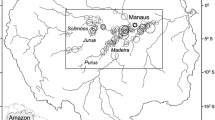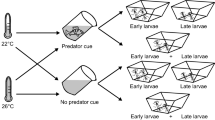Abstract.
We investigated how the lethal and non-lethal presence and absence of a fish predator, perch (Perca fluviatils), influenced behaviour, numbers emerging, size at emergence, and development rate of the damselfly Lestes sponsa. The experiment was carried out in outdoor artificial ponds and spanned from the egg stage to emergence of the damselflies. During the experiment food resources for the damselflies were continuously monitored. Damselflies exposed to a lethal predator showed a significantly lower activity level than those in the absence of predators or subjected to a non-lethal predator. Half-way through the larval stage the reduction in activity level was correlated with the presence of lethal predators, and at the end of the larval stage with higher zooplankton densities. Though larvae decreased activity level, size at emergence was larger and development time faster for individuals in the lethal predator treatment. Since fewer larvae emerged from that treatment we interpret the larger size at emergence to be an effect of a combination of thinning and higher zooplankton densities.
Similar content being viewed by others
Author information
Authors and Affiliations
Corresponding author
Additional information
Electronic Publication
Rights and permissions
About this article
Cite this article
Brodin, T., Johansson, F. Effects of predator-induced thinning and activity changes on life history in a damselfly. Oecologia 132, 316–322 (2002). https://doi.org/10.1007/s00442-002-0938-0
Received:
Accepted:
Published:
Issue Date:
DOI: https://doi.org/10.1007/s00442-002-0938-0




